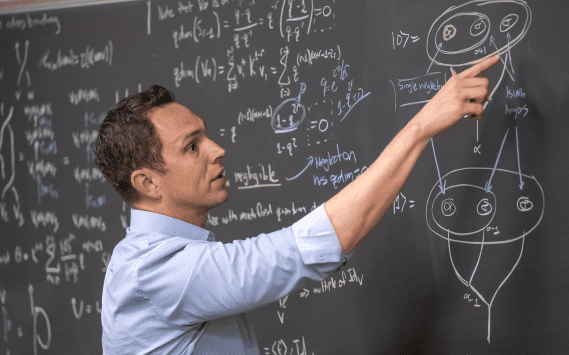Science
Mathematicians Discover ‘Neglectons’ for Advanced Quantum Computing

Researchers in the United States have made a significant breakthrough in the field of quantum computing by identifying a new class of quasiparticles named “neglectons.” This discovery could enhance the capabilities of topological quantum computers, which are renowned for their potential robustness compared to traditional quantum systems. The findings were published by a collaborative team of mathematicians and physicists, led by Aaron Lauda from the University of Southern California.
Quantum computers harness fragile quantum states to achieve remarkable computational power. While the concept of topological quantum computing offers a more stable approach, existing methods limit the variety of calculations these computers can perform. The newly discovered neglectons could change this by broadening the range of quantum computations possible with topological states.
Understanding Anyons and Their Role in Quantum Computing
The quantum bits, or qubits, used in topological quantum computers are based on anyons, which are particle-like entities emerging from the interactions of electrons in two-dimensional materials. Unlike conventional particles, anyons behave uniquely; their states can only be altered by manipulating their positions relative to one another through a process known as “braiding.”
Yet not all anyons are suitable for quantum computing. Certain anyons derived from mathematical symmetries, as noted by Lauda, possess a quantum dimension of zero, rendering them ineffective for manipulation in quantum computations. Traditionally, researchers would discard these particles, limiting the computational gates available to those based on Ising anyons. These gates, known as Clifford gates, can be efficiently simulated by classical computers, which diminishes their potential for revolutionary quantum machines.
Revisiting Topological Quantum Field Theory
Lauda’s interest was piqued by advancements in mathematical tools applicable to anyons. Notably, in 2011, researchers Nathan Geer from Utah State University, Jonathan Kujawa from Oklahoma University, and Bertrand Patureau-Mirand from Université de Bretagne-Sud demonstrated that objects previously considered zero-dimensional in topological quantum field theory (TQFT) could be manipulated in novel ways.
“This discovery opens up a new perspective on the capabilities of anyons,” remarked Geer, who was not involved in Lauda’s recent research. The team’s innovative approach to TQFT allowed them to reconsider the contributions of anyons that had previously been overlooked. Surprisingly, they found that incorporating certain discarded anyons—dubbed “neglectons”—into their model enables the braiding of Ising anyons, thus expanding the potential for quantum computations.
Nevertheless, integrating neglectons into the model introduced challenges, notably the loss of unitarity, a critical property in the probabilistic interpretation of quantum mechanics. Lauda explained that this aspect often causes discomfort among physicists. To overcome this, Filippo Iulianelli, a graduate student under Lauda, devised creative solutions to constrain the computational space, ensuring that anyon transformations remained unitary.
The implications of this research are profound, according to Shawn Cui of Purdue University, who focuses on topological quantum field theory and quantum computation. Cui described Lauda’s work as a significant theoretical advancement that could help address the limitations of traditional semisimple models. However, he cautioned that translating this theoretical progress into practical application remains a long-term objective.
Lauda noted that historical precedents exist for the discovery of particles following the application of mathematical symmetry principles. He cited Murray Gell-Mann’s prediction of the omega minus baryon in 1962 as an example. “We already observe Ising anyons in certain systems,” Lauda stated. “We should also actively search for these neglectons in such environments.”
The team’s findings pave the way for further exploration in quantum computing, potentially leading to more powerful and versatile systems that leverage the unique properties of neglectons. As researchers continue to delve into this promising area, the future of quantum computation may very well hinge on these previously overlooked quasiparticles.
-

 Entertainment2 months ago
Entertainment2 months agoIconic 90s TV Show House Hits Market for £1.1 Million
-

 Lifestyle4 months ago
Lifestyle4 months agoMilk Bank Urges Mothers to Donate for Premature Babies’ Health
-

 Sports3 months ago
Sports3 months agoAlessia Russo Signs Long-Term Deal with Arsenal Ahead of WSL Season
-

 Lifestyle4 months ago
Lifestyle4 months agoShoppers Flock to Discounted Neck Pillow on Amazon for Travel Comfort
-

 Politics4 months ago
Politics4 months agoMuseums Body Critiques EHRC Proposals on Gender Facilities
-

 Business4 months ago
Business4 months agoTrump Visits Europe: Business, Politics, or Leisure?
-

 Lifestyle4 months ago
Lifestyle4 months agoJapanese Teen Sorato Shimizu Breaks U18 100m Record in 10 Seconds
-

 Politics4 months ago
Politics4 months agoCouple Shares Inspiring Love Story Defying Height Stereotypes
-

 World4 months ago
World4 months agoAnglian Water Raises Concerns Over Proposed AI Data Centre
-

 Sports4 months ago
Sports4 months agoBournemouth Dominates Everton with 3-0 Victory in Premier League Summer Series
-

 World4 months ago
World4 months agoWreckage of Missing Russian Passenger Plane Discovered in Flames
-

 Lifestyle4 months ago
Lifestyle4 months agoShoppers Rave About Roman’s £42 Midi Dress, Calling It ‘Elegant’









